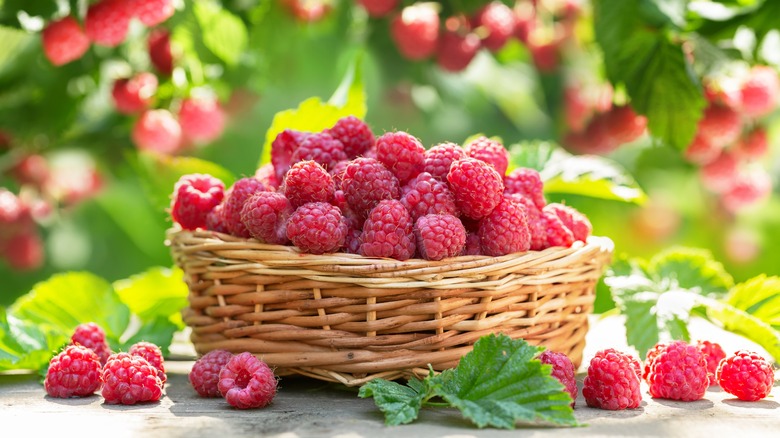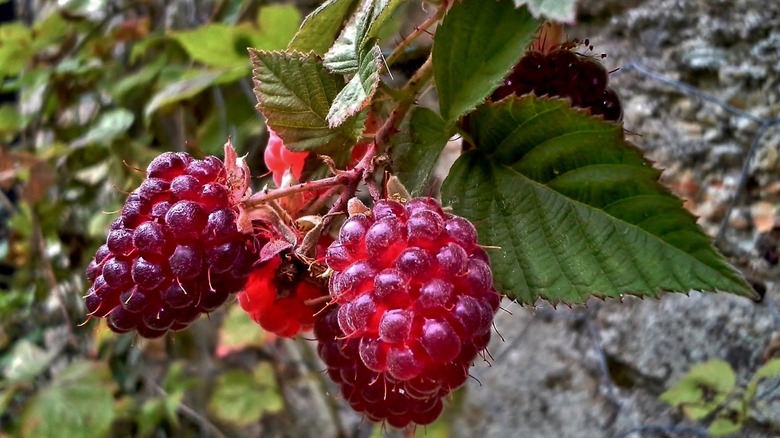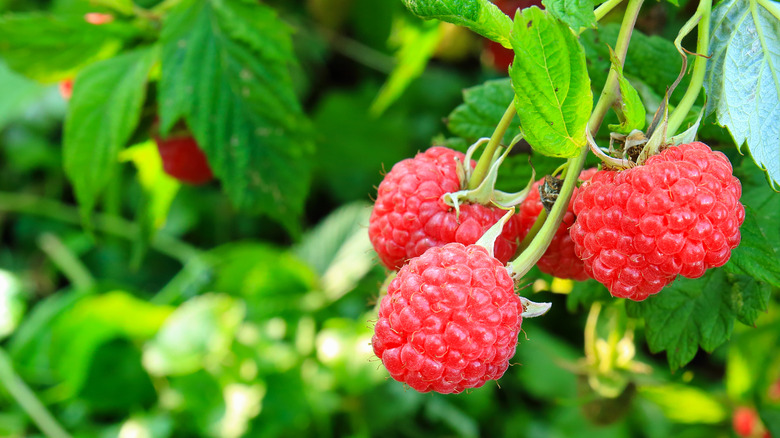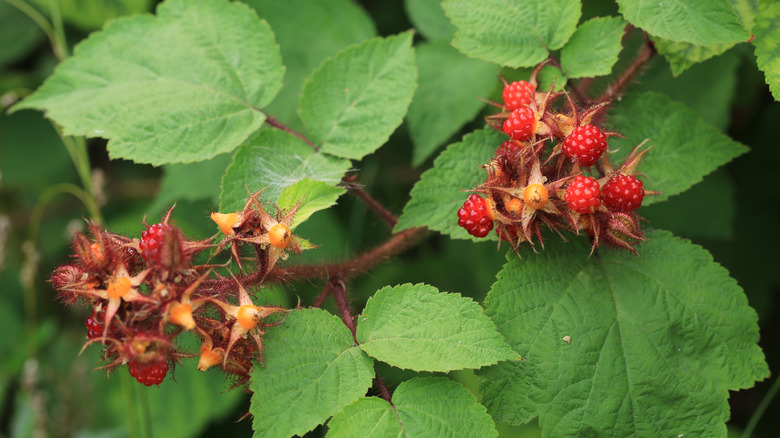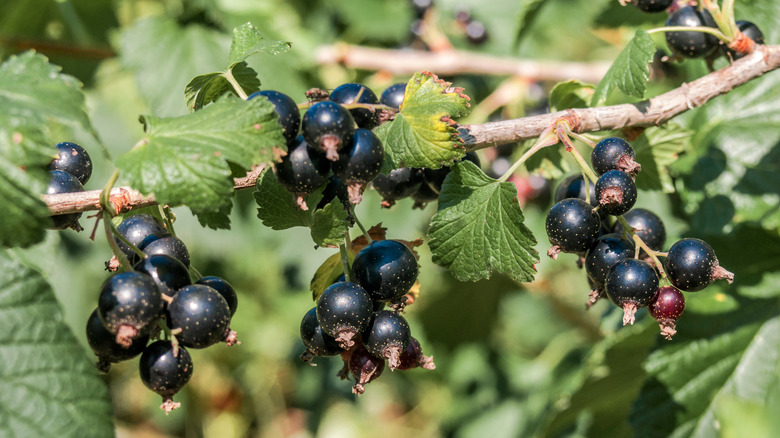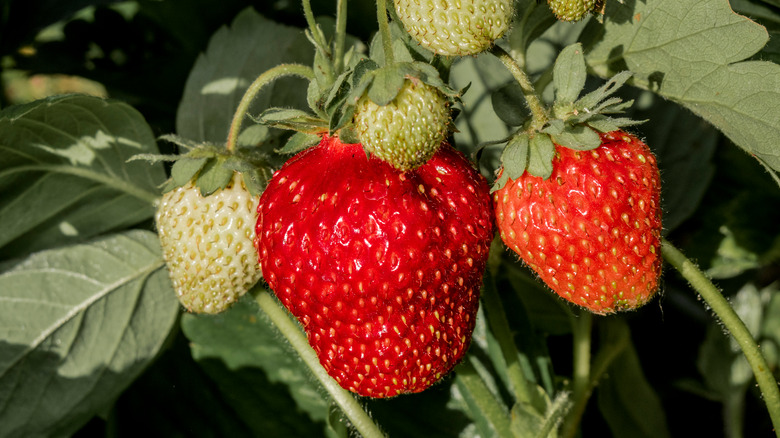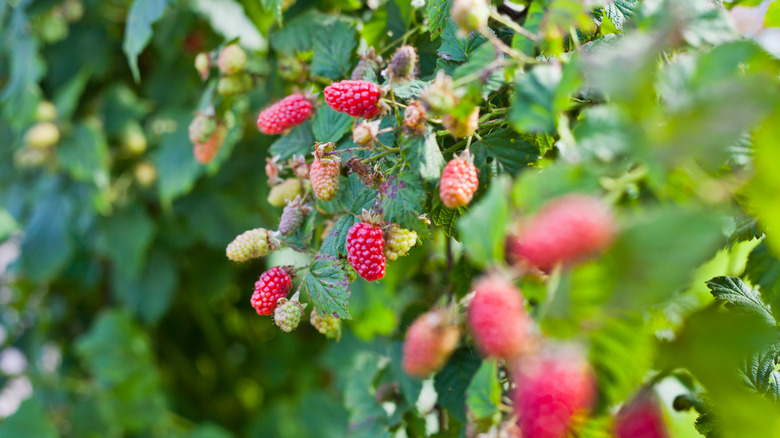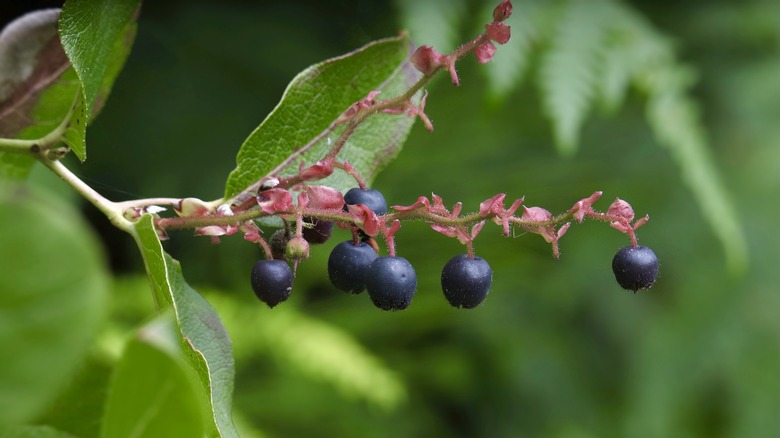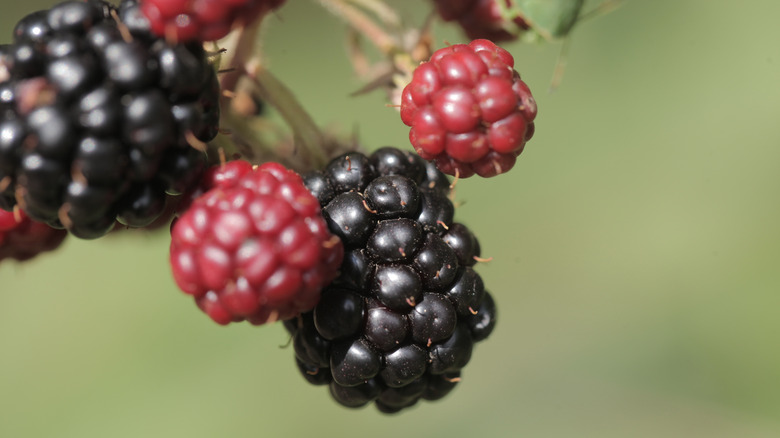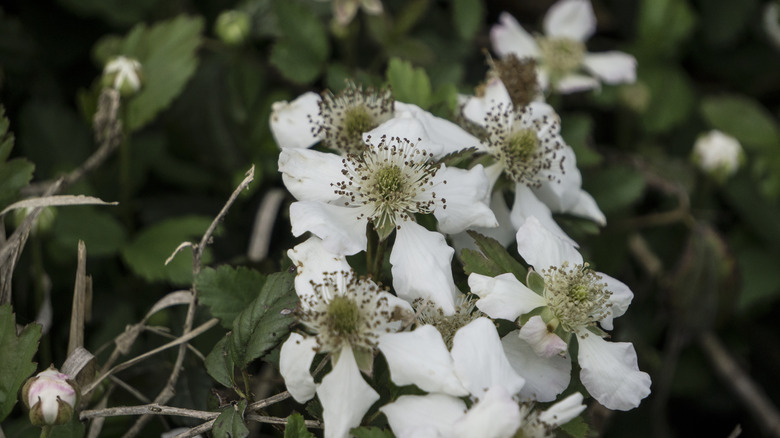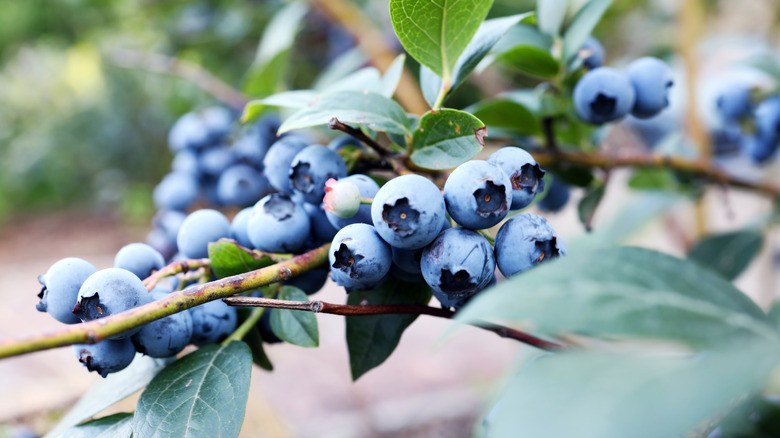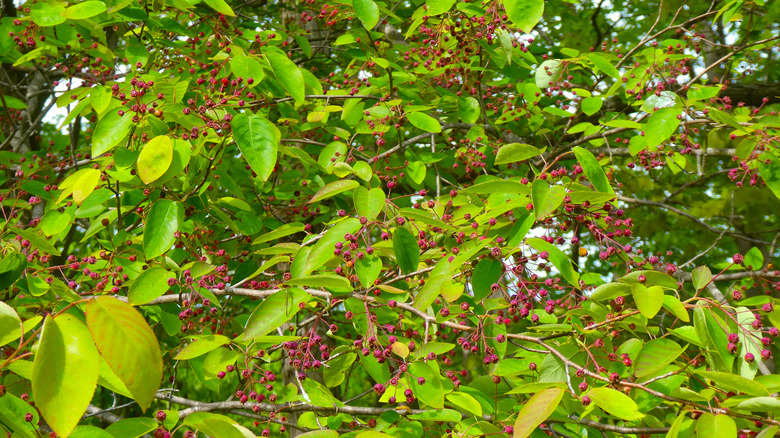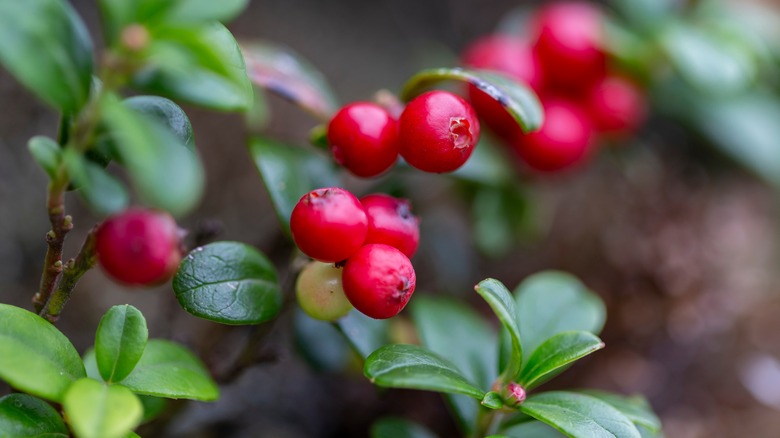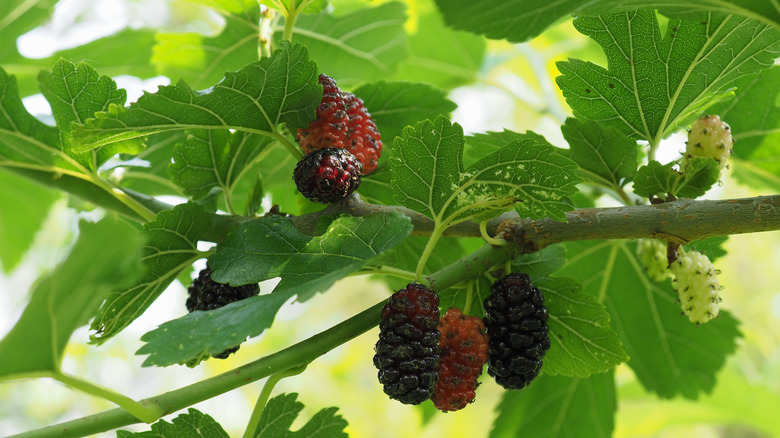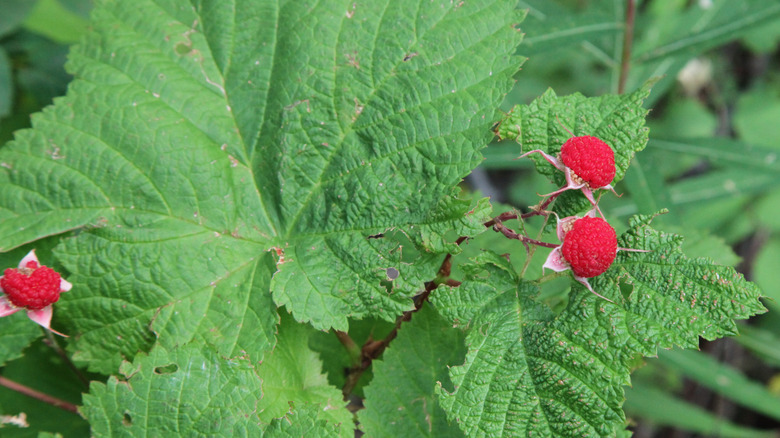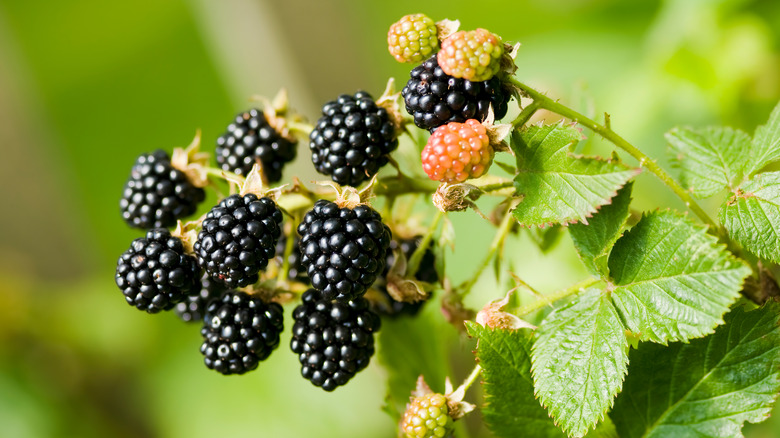15 Berry-Producing Bushes Perfect For Your Yard
Nothing is sweeter than berries grown in your own backyard. After putting in the work to plant, nurture, and harvest your berry plants, you can kick back and enjoy organic jam, jelly, juice, or baked goods packed with your favorite tiny fruits. Berries you can find at the grocery store, such as raspberries, blueberries, strawberries, and blackberries, are all excellent options for growing. However, you can also cultivate something more uncommon like lingonberries, wineberries, or marionberries!
There is almost no limit when it comes to growing your own fresh berries. As long as you live somewhere between USDA zones 3 to 10, there is a berry bush for you to grow at home. Thankfully, many of these berry-producing plants produce their fruit simultaneously, as stated by Stark Bro's Nurseries & Orchards Co. So, if you want to make a fresh berry smoothie, you won't have to wait too long between harvesting each of your bushes. Go forth and grow your favorite berries at arms' reach.
1. Loganberry bushes
Loganberries (Rubus x loganobaccus) grow on large shrubs that prefer partially shady locations in woodland environments, as per Plants for a Future. The fruit looks similar to raspberries, but it is longer and tastes tart but flavorful. Gardeners enjoy using them in jellies, jams, and baked goods like muffins.
Bloom Season: Summer
USDA Growing Zone: 7 to 10
Growing Conditions: Full sun to partial shade
Soil Type: Well-drained clay, sand, or loam
Size: 8 feet tall and wide
2. Raspberry bushes
Raspberry bushes (Rubus idaeus) are known for their sweet fruit that is tasty to both birds and humans. These bushes are native to North America, northern Asia, Europe, and Japan, where they rapidly colonize through suckers, explains Missouri Botanical Garden. You can easily grow raspberry bushes on your own lawn when you provide it with plenty of water, sun, and room to grow.
Bloom Season: Spring
USDA Growing Zone: 4 to 8
Growing Conditions: Full sun
Soil Type: Well-drained, organically rich, and mildly acidic
Size: 3 to 9 feet tall and wide
3. Wineberry bushes
Wineberries (Rubus phoenicolasius) are relatives of dewberries, blackberries, and raspberries, as defined by the North Carolina Extension Gardener Plant Toolbox. The bush can become weedy, which has led to it becoming banned in some states such as New York. You can identify wineberry bushes by their red-orange fruit, white to red star-shaped flowers, and red stems.
Bloom Season: Spring and summer
USDA Growing Zone: 4 to 8
Growing Conditions: Full sun to partial shade
Soil Type: Well-drained loam, sand, or clay
Size: 9 feet tall
4. Blackcurrant bushes
Blackcurrant bushes (Ribes nigrum) are ornamental landscape shrubs that produce fragrant, edible berries in the summer, as noted by the University of Minnesota. These berries are used to make sauces, jellies, jams, and juice. They are also commonly used in dietary supplements due to their high antioxidant content. The bushes are somewhat high maintenance but tolerant of urban conditions, making them a great addition to any backyard.
Bloom Season: Spring
USDA Growing Zone: 3 to 7
Growing Conditions: Full sun to partial shade
Soil Type: Well-drained and rich
Size: 3 to 4 feet tall and wide
5. Strawberry plants
Strawberries (Fragaria × ananassa) are in the rose family like many other berries. A clumping perennial, the strawberry plant is well-known for its tiny, white blossoms and sweet, red fruit. According to the North Carolina Extension Gardener Plant Toolbox, this plant can be grown in garden beds, planters, and even hanging baskets.
Bloom Season: Spring
USDA Growing Zone: 5 to 9
Growing Conditions: Full sun to partial shade
Soil Type: Moist clay or loam with good drainage
Size: 6 inches to 1 foot tall
6. Boysenberry bushes
Boysenberries (Rubus ursinus × Rubus idaeus) are hybrid berries made by crossing a raspberry, a dewberry, a loganberry, and a blackberry, via Phoenix Perennials. The boysenberry plant produces sizeable dark red to black berries when you provide it with good care. Boysenberry bushes need rich soil, regular watering, and yearly pruning for the best results.
Bloom Season: Spring
USDA Growing Zone: 5 to 9
Growing Conditions: Full sun to partial shade
Soil Type: Well-drained and organically rich
Size: 4 to 6 feet tall
7. Huckleberry bushes
Huckleberries (Vaccinium membranaceum) are a favorite in the Pacific Northwest region of the United States. They typically grow in high elevations in the forest. However, with the right conditions, you can grow them in your very own yard. They thrive nicely on slopes with organic soil or in rock gardens, as explained by Native Plants PNW.
Bloom Season: Late spring to early summer
USDA Growing Zone: 5 to 9
Growing Conditions: Full sun to partial shade
Soil Type: Well-drained loam or sand
Size: 1 to 5 feet tall
8. Marionberry bushes
Marionberry bushes (Rubus 'Marion') are a cross between raspberry and blackberry bushes. The marionberry itself can be dark red or black and tastes pretty sweet. Marionberry plants grow very fast and should be cultivated around a fence or wall to support their growth habit, as mentioned by Monrovia. The bush is easy to care for as long as you provide weekly waterings and full sun conditions.
Bloom Season: Spring
USDA Growing Zone: 7 to 9
Growing Conditions: Full sun
Soil Type: Well-drained fertile, and mildly acidic
Size: 4 feet tall and 6 feet wide
9. Southern dewberry bushes
Dewberry bushes (Rubus trivialis) are not typically grown for commercial use. In some states, you can often find them growing on stream banks, roadsides, and in old fields, says Plants For a Future. The dewberry is a sweet edible fruit that can be eaten raw, made into jam, or used to make purple dye.
Bloom Season: Spring
USDA Growing Zone: 5 to 9
Growing Conditions: Full sun to part shade
Soil Type: Well-drained loam, sand, or clay
Size: 3 feet tall
10. Blueberry bushes
Highbush blueberry bushes (Vaccinium corymbosum) are flowering deciduous shrubs that provide outstanding ornamental value year-round. The bushes' stems turn red in the winter, lush green foliage appears in the spring, delicious blueberries pop up in the summer, and its leaves change color in the fall, as told by Jersey-Friendly Yards.
Bloom Season: Late spring to early summer
USDA Growing Zone: 4 to 7
Growing Conditions: Full sun to partial shade
Soil Type: Well-drained and organic
Size: 6 to 12 feet tall
11. Serviceberry bushes
Serviceberries (Amelanchier arborea) come from a small tree native to eastern North America. As explained by North Carolina Extension Gardener Plant Toolbox, these berries are compared to highbush blueberries, but they taste sweeter. The tree is a part of the rose family and bears fragrant white flowers before producing fruit in the summer. Growing this tree is difficult for some as it is susceptible to several diseases and pests.
Bloom Season: Spring
USDA Growing Zone: 4 to 9
Growing Conditions: Full sun to partial shade
Soil Type: Moist clay, loam, or sand
Size: 15 to 25 feet tall
12. Lingonberry bushes
Lingonberry bushes (Vaccinium vitis-idaea) are somewhat difficult to care for as they can't tolerate much heat, foot traffic, or too much water, as warned by Missouri Botanical Garden. This bush is mat-forming as it will only become about 1 foot tall, but it will spread to more than 3 feet wide through underground rhizomes. Its berries are commonly used in jams and jellies.
Bloom Season: Spring
USDA Growing Zone: 3 to 7
Growing Conditions: Full sun to part shade
Soil Type: Well-drained peaty loam
Size: 1 to 3 feet wide and 3 to 12 inches tall
13. Mulberry bushes
Mulberry bushes (Morus alba) are technically small trees that bear delicious berries. These berries first appear white in the late spring or early summer, and they slowly turn pink, red, and then a purple-black color, as told by Gardenia. This tree is easy to care for once established in your yard, and it needs bright, direct sunlight and just some pruning in the winter.
Bloom Season: Spring
USDA Growing Zone: 4 to 8
Growing Conditions: Full sun
Soil Type: Well-drained chalk, loam, clay, or sand
Size: 30 to 50 feet tall
14. Thimbleberry bushes
Thimbleberry bushes (Rubus parviflorus) are rarely grown for commercial use, which makes cultivating your own so rewarding. Thimbleberries are from the same genus as raspberries and blackberries, but they are much softer, which makes them great for making jam and jelly, as per Missouri Botanical Garden.
Bloom Season: Spring to summer
USDA Growing Zone: 3 to 10
Growing Conditions: Full sun to part shade
Soil Type: Well-drained, rich, and somewhat acidic
Size: 4 to 8 feet tall and wide
15. Blackberry bushes
Blackberry bushes (Rubus fruticosus) are tall plants that need full sun, rich soil, and lots of room to grow. These bushes can be quite demanding as they are susceptible to disease and other problems. UIC Heritage Garden warns you to watch out for blackberries turning orange because it indicates that the berry has been infected by a fungus.
Bloom Season: Spring
USDA Growing Zone: 5 to 9
Growing Conditions: Full sun
Soil Type: Well-drained and organically rich
Size: 5 to 9 feet tall and wide
